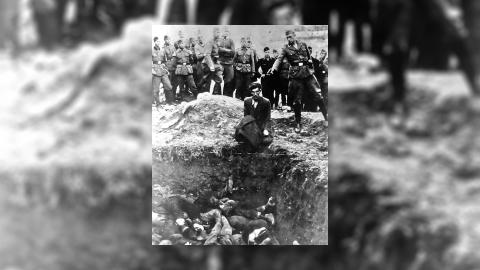
Field of Vampires: The mysterious mass grave of 450 vampires found in Poland
Hundreds of so-called vampires were discovered in a small town in northern Poland, with the bizarre burial practices shedding light on the ancient beliefs of the times.
Image: A pile of human skulls lie on the forest floor in an abandoned cemetery | Shutterstock.com
Field of Vampires investigates a skeleton buried with a sickle across her neck and a padlock on her toe – a corpse that was feared to be a real-life vampire. The show starts 29th October at 9pm on Sky HISTORY.
Thanks to literary and cinematic classics like Bram Stoker’s Dracula and F W Murnau’s Nosferatu, the legend of the vampire has pervaded all across the world today.
However, it’s easy to forget that these tales were rooted in ancient superstition and popular folklore (the creation of Dracula was said to have been inspired by the real-life warlord Vlad the Impaler, for example) and at one time, they were treated far more seriously than mere popcorn-fodder.
The 2023 discovery of a mass burial site of 450 individuals in a sleepy Polish town is testament to that fact – especially since many of the cadavers were dismembered as part of anti-vampiric rituals and practices popular at the time.
An unusual discovery
The mass grave was stumbled upon by roadworkers in the hamlet of Luzino in northeast Poland, who were excavating the land to expand the thoroughfare. During the course of their labours, they unearthed the remains of hundreds of individuals near a church.
So far, so normal. However, the extraordinary thing about the discovery was the rituals that had been performed upon the cadavers after death. Some of the skeletons had been decapitated, with the skull then placed between their legs, while others carried coins in their mouths. More still had piles of bricks placed around their head and limbs.
‘It was believed that if someone from the deceased's family died right after the funeral, they could be a vampire,’ explained Maciej Stromski, an archaeologist summoned to the site. ‘That is why after the burial the grave was dug up and the deceased's head was cut off, which was then placed at the feet. We also discovered an example of a woman after decapitation. Only the skull of a child was placed on her womb.’
Apparently, the coins were inserted into the mouth of the deceased as a means of warding off vampires (who regard silver as anathema), as well as sealing their soul inside their body and paying for their passage to the underworld.
Par for the course for Poland
The discovery of 450 so-called vampires is certainly a shocking revelation that made headlines around the world – but it’s far from the first time that Poland has been the site of excavations undercovering anti-vampiric practices.
In 2008, several decapitated skeletons were found at a burial site near Gliwice, with others having holes drilled through their legs or bricks inserted into their mouths. Then in 2022, a 17th-century female vampire was found near Bydgoszcz with a sickle placed across her neck and a padlock securing her big toe.
The sickle was clearly situated so as to cut the throat of the undead if she rose from her eternal slumber, but the padlocked toe – believed to symbolise the closing of the life cycle of the woman – has got to be one of the stranger punishments doled out to those accused of unnatural doings from yesteryear.
The 450-strong vampire grave in Luzino was unearthed last year, while 2024 has already seen the shocking discovery of two children given the same anti-vampiric treatment. The youngsters, who it is believed were buried as far back as the 13th century, were found during the routine removal of tree roots at a cathedral in Chem.
A very Eastern European tradition
While the origins of a blood-sucking creature can be traced back millennia to cultures as distinct and disparate as Mesopotamia, Greece, China and Egypt, the one we’re all familiar with today has a more Slavic feel. Indeed, there are numerous stories of supposed 'real-life vampires' from countries such as Poland and Serbia.
As such, the idea of the vampire popularised in Halloween costumes worldwide has been born from these traditions, which were passed down from generation to generation through folk tales and literature. But the burial sites in Poland attest to the fact that fear of the undead was, at one time in history, a very real phenomenon.
Such discoveries are an illuminating window into how the minds of our forebears worked – and the lengths they were willing to go to in order to banish evil spirits and keep their societies safe.
In any case, the 450 vampires found in Luzino have suffered their second upheaval in as many centuries. After thorough inspection and documentation, the bones were respectfully returned to the earth and it’s hoped that the dead can finally receive some semblance of peace from here on in.



















